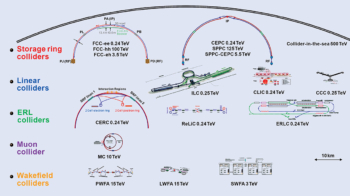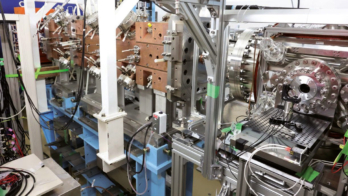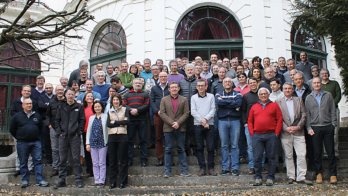Jochen Schneider and Ilka Flegel tell the story of DESY’s

Image credit: DESY.
The FLASH free-electron laser at DESY is the first user facility to deliver, over the past five years, short and intense light pulses in the vacuum ultraviolet (VUV) and soft X-ray region. As such, it provides the photon-science community with unprecedented opportunities to explore new territory, ranging from physics via chemistry to biology.
FLASH was initially built as a test facility for the “TESLA Linear Collider with Integrated X-Ray Free-Electron Laser Facility”. At the beginning of the 1990s, DESY initiated a vigorous R&D programme towards an e+e– linear collider. Because there were indications from the funding agencies in Germany that such a facility should be attractive not just to the particle-physics community, DESY and its international partners developed a conceptual design for a 500 GeV e+e– linear collider featuring an integrated X-ray laser facility – the TESLA project.
Based on the good experience with superconducting technology at the hadron–lepton collider HERA at DESY and the need for high luminosity at the linear collider, the challenge to realize the accelerator in superconducting RF technology was taken up by a large international effort, the TESLA collaboration. To achieve the ambitious goal of increasing the accelerating gradient while reducing the cost of the cryomodules, in each case by a factor of five, DESY built a test facility and decided to combine it with a free-electron laser (FEL) in the VUV spectral range.
Pioneering with the TTF
With excellent results achieved at the TESLA Test Facility (TTF), in March 2001 the collaboration published the technical design report for the TESLA project. In February 2003, the German government decided that the X-ray FEL part of the proposal should be realized in Hamburg as a European project, with Germany paying half of the cost. Construction of the facility, named the European XFEL, started in January 2009 and the first electron beams are expected in 2014. As for the TTF, it was expanded and converted to the soft X-ray FEL user facility FLASH, which has been serving the photon-science community at DESY since August 2005.

Image credit: DESY.
The FLASH experimental area. The FEL beam can be switched to five experimental stations (in the background close to the window) by moving plane mirrors. Similarly, a synchronized optical-laser beam can be transported in vacuum to each of the stations by switching plane mirrors, which are mounted in the four cylindrical vacuum vessels in the foreground. The optical laser is located in a hutch on the right, just outside the picture.
Image credit: DESY.
In its first stage of expansion, the approximately 100 m-long TTF consisted of a low-emittance laser-driven photocathode electron gun, a pre-accelerator, two superconducting accelerator modules, three sections of undulator structures (each 4.5 m long) and various electron- and photon-beam diagnostics. Lasing at saturation at a wavelength of 98 nm was achieved in September 2001, setting a world first and proving the feasibility of FELs using the principle of self-amplified spontaneous emission (SASE) in the VUV range. Subsequently, tunability between 80–120 nm was demonstrated, as well as a high degree of lateral coherence of the beam. The duration of the gigawatt radiation pulses was estimated to be between 30 and 100 fs, but a tool for the direct measurement of such ultrashort pulses was not available at the time. The peak brilliance of the FEL radiation was around 1029 photons/(s mrad2 mm2 0.1% bandwidth), i.e. about eight orders of magnitude higher than that available at the best synchrotron radiation storage rings.
Given the huge increase in brilliance from state-of-the-art third-generation synchrotron sources to FELs, it is crucial for all experiments performed at FELs to understand the interaction of the extremely intense, ultrashort X-ray pulses with matter on the atomic and molecular level. It was therefore natural to perform the first experiments at the TTF on atoms and clusters, the latter being on an intermediate scale between atoms and condensed matter.

Thomas Möller’s group studied xenon clusters using 98 nm FEL radiation at power densities up to 7 × 1013 W cm–2 (Wabnitz et al. 2002). The most striking result revealed in the single-shot time-of-flight mass spectra is the big difference between the spectra measured for xenon atoms and for large clusters. Whereas only single-charged ions are observed after irradiation of isolated atoms, atomic ions with charges up to 8+ are observed when irradiating clusters, although the photon energy of 12.7 eV is only slightly higher than xenon’s ionization potential of 12.1 eV. This effect is strongly dependent on the power density of the photon pulses. At a power density of 7 × 1013 W cm–2, each atom in large clusters absorbs up to 400 eV, corresponding to 30 photons during about 100 fs, the duration of the FEL pulse. Möller’s team suggests that the clusters are heated up very efficiently by the VUV radiation. Electrons are emitted after acquiring sufficient energy, before the clusters finally disintegrate completely by Coulomb explosion. These first results obtained at the TTF stimulated a broad discussion in the community and a wealth of further experimental and theoretical work.
The operation of the first stage of expansion of the TTF, where emphasis was on the development and test of the superconducting linac for the TESLA project, was concluded in December 2002. In the next phase it was extended to 260 m and converted to a soft X-ray FEL user facility, the commissioning of which started in autumn 2004. The first lasing at a wavelength of 32 nm – another world record – was observed in January 2005. After the official start of user operation in August 2005, the facility was renamed FLASH, for Free-Electron Laser in Hamburg.
The FLASH user facility
Compared with the first expansion stage, the most important changes were the increase in electron energy from about 240 MeV to 700 MeV by adding/replacing cryomodules, installing a second bunch-compressor, increasing the number of undulators from three to six and installing a collimator section to protect the undulator against bremsstrahlung and in case of electron-beam steering accidents. The electron bypass allowed accelerator studies without danger of damaging the undulators. Additionally, an experimental station was installed in the bypass inside the tunnel for damage and other studies using the electron beam. Later, a sixth cryomodule was added and the electron energy increased to around 1 GeV, which enabled lasing at 6.5 nm, first observed in October 2007. The photon beams are delivered to five experimental stations in the FLASH experiment hall.
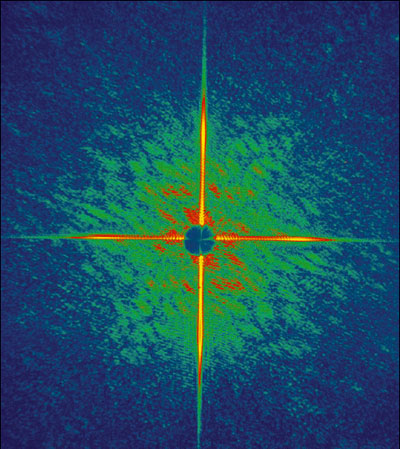
Image credit: DESY.
In 2006/2007, the spectral range of FLASH was also extended into the far-infrared (IR) by installing a long-period undulator and a new IR beamline. The device produces intense, truly synchronized IR pulses tunable in a broad spectral range, e.g. for two-colour pump-probe experiments. The first experiments at the IR beamline aimed to determine the spatial and temporal properties of individual pulses from FLASH and to unveil their temporal substructure.
During a major upgrade from September 2009 to February 2010, key components of FLASH were replaced or improved. A third-harmonic accelerator module that is now installed creates a much more homogeneous electron distribution in the bunch. Also, the linac was fitted with a seventh cryomodule, boosting the electron energy to 1.2 GeV and the wavelength to 4.45 nm. At the end of September 2010 the electron energy was pushed to 1.25 GeV and FLASH achieved lasing at 4.12 nm, thus reaching the “water window” in the fundamental harmonic, which opens up exciting new research opportunities for biological studies in particular.
In addition, an external “seeding” experiment called sFLASH has been installed. With sFLASH, the FEL process is seeded by pulses of 38 nm wavelength and 20 fs (FWHM) in duration, which are produced via high-harmonics generation. These pulses are overlaid with the FLASH electron bunches and amplified by being passed through 10 m of undulators. The photon beam is reflected out to an experimental hutch where time-resolved, pump-probe experiments will be pursued. The goal is to run the seeded FEL parasitically to normal FLASH operation by taking only one bunch out of each bunch train.
Recently, the decision was taken within the Helmholtz Association of German Research Centres to construct an extension of FLASH by adding a second undulator beamline and a second experimental hall with up to six experimental stations. The extension will have tunable gap undulators, use various seeding schemes and in a later stage provide polarized FEL radiation.
First experiments with FLASH
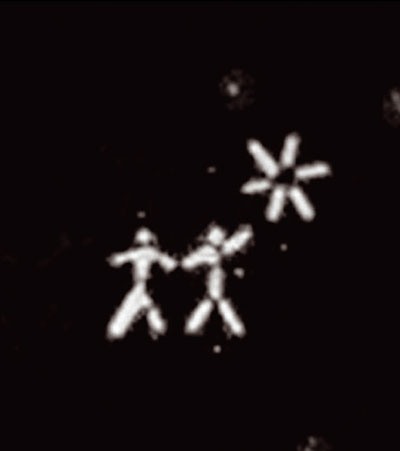
Image credit: DESY.
FLASH is the world’s first FEL user facility in the VUV and soft X-ray spectral range, and many pioneering experiments in a large variety of fields have been performed to date. These include work on atoms, molecules and clusters; matter in extreme conditions, warm dense matter, radiation damage; single-shot, lensless imaging of cells and diffraction from nanoscale crystals; condensed matter spectroscopy and scattering; and photon-beam diagnostics. Today the FLASH website lists 126 publications in refereed journals.
One of the most attractive scientific drivers for X-ray FELs is the single-shot coherent imaging of nanoscale objects. Obtaining enough signal in a single-shot image requires about 1012 photons focused on a spot a few micrometres in diameter. However, such high-power densities destroy the sample and the question is whether an experiment can obtain the structural information before the target explodes. Model calculations show that to achieve this goal, the duration of the FEL pulses should be of the order of 10 fs. Henry Chapman and colleagues have performed the proof-of-principle experiment at FLASH using intense (4 × 1013 W cm–2) pulses of around 25 fs duration that contain some 1012 photons at 32 nm wavelength (Chapman et al. 2006). Figure 1 shows the experimental set-up. The graded multilayer mirror also acts as a filter for the 32 nm FEL radiation and thus improves the signal-to-noise ratio on the CCD detector. Figure 2 shows the single-shot scattering picture, together with the reconstructed image. The agreement with the transmission electron microscopy picture of the target shown in figure 1 is excellent. After transmission of the FLASH pulse, the target heats up to about 60,000 K on picosecond timescales. As a result, the scattering picture taken later with a second FLASH pulse corresponds essentially to a hole in the target.
Figure 3 shows the spectral peak brilliance calculated for FLASH, the Linac Coherent Light Source (LCLS) at SLAC (Making X-rays: bright times ahead for FELs) and the future European XFEL, in comparison with the performance of third-generation synchrotron radiation facilities. Overall, the gain with FELs amounts to approximately nine orders of magnitude. It is interesting to note that the experimental results achieved at FLASH for the fundamental harmonic at 13.7 nm, as well as for the third and fifth harmonics, nicely reproduce the earlier theoretical predictions. The peak brilliance exceeds 1030 photons/(s mrad2 mm2 0.1% bandwidth) and for an average pulse energy of 40 μJ of the fundamental at 13.7 nm, a power of 0.25 ± 0.1 μJ was measured for the third (4.6 nm) and 10 ± 4 nJ for the fifth (2.75 nm) harmonic. By going to higher-order radiation, the number of photons per pulse is reduced by two to four orders of magnitude. These weaker beams allow, for example, the spectroscopic studies of condensed matter where the full beam intensity would create space charges that mask the ground-state properties of the system under investigation. For example, in combination with a synchronized optical laser, femtosecond time-resolved, core-level photoelectron spectroscopy experiments were performed at FLASH using 118.5 ± 0.2 eV photons from the third harmonic.
FELs such as FLASH have already opened up new vistas in time-resolved science. With the advent of X-ray lasers of even shorter wavelengths with shorter pulses and higher peak powers, such as the LCLS in the US, the SPring-8 XFEL in Japan and the European XFEL in Germany, the photon-science community will finally accomplish the transition from the study of static systems to time-resolved investigations of the dynamics of physical, chemical and biological processes on atomic length and timescales.



